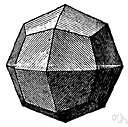Or if the Shining
Trapezohedron in the abandoned church can summon a winged demon?
This problem consists of computing the total charge of a
trapezohedron at 1V from the induced charge on its surface.
The most common forms are the dodecahedron {110} and
trapezohedron {211} in various combinations, the first being more typical for demantoid and the second for topazolite.
In the tower of the now abandoned yet accursed church where a malevolent cult called Starry Wisdom once congregated in "The Haunter of the Dark," the narrator recounts how Robert Blake, the story's protagonist, finds an object referred to as the Shining
Trapezohedron suspended inside a small box whose artistry and peculiarity underscore the value of the object it contains: "He noticed odd bas-reliefs on the strange open box of yellowish metal [...] the figurings [sic] were of a monstrous and utterly alien kind; depicting entities which, though seeming alive, resembled no known life-form ever evolved on this planet" ("Haunter," 102, emphasis added).
(2) En el cuento citado, "The Haunter in the Dark" (1935), hay otras referencias semejantes: "there are references to a Haunter of the Dark awakened by gazing into the Shining
Trapezohedron, and insane conjectures about the black gulfs of chaos from which it was called" (The Call 350); "the monstrous thing of night which his rashness had called out of the ultimate black spaces" (353); "he thought of the ancient legends of Ultimate Chaos" (354).
The thumbnail-size almandine crystals are lustrous, partially gemmy, red-brown combinations of the dodecahedron and
trapezohedron forms, with nice internal highlights.
The following forms were identified: the rhombic dodecahedron, the pyritohedron, the
trapezohedron, several dyakis dodecahedra, and probably the triakis octahedron [= trisoctahedron], Wagner stated that the Tweefontein sperrylite crystals are typically 1.3 mm to 1.7 cm in size.
One of the clefts also yielded colorless, transparent fluorite octahedrons, modified by dodecahedron and
trapezohedron faces, to 2 cm; good crystals of adularian orthoclase, smoky quartz and white tabular calcite also came from both clefts (Burgsteiner, 1989; Niedermayr, 1990).
Forms present are the cube (a), octahedron (o), dodecahedron (d), tetrahexahedron (e) {012},
trapezohedron (m) {113}, trisoctahedron (q) {133}, and hexoctahedron (t) {124}.
Enantiomorphic "handedness" is revealed by the
trapezohedron face x in its right x'{161} or left 'x{151} position (see Figs.
There is also--and this is part of what I meant earlier by "playful"--a piece by Erich Offermann and Pete Richards called "Fluorite Balls From Hell," in which a computer-enabled, almost insanely detailed crystallographic analysis is offered of tiny fluorite crystals from Germany which typically look like spheres because they combine the hexoctahedron (48 faces), tetrahexahedron (24 faces), cube, dodecahedron,
trapezohedron and (for all I could tell, on a quick read) even more isometric forms, all in more or less equal development.
He also noticed that the presence and orientation of the composite x or 'x trigonal
trapezohedron face (see later) betrays the handedness of the gwindel (Weiss, 1836).
 trapezohedron - a polyhedron whose faces are trapeziums
trapezohedron - a polyhedron whose faces are trapeziums